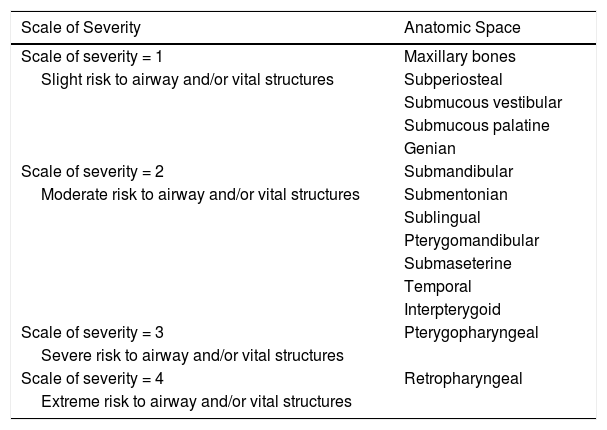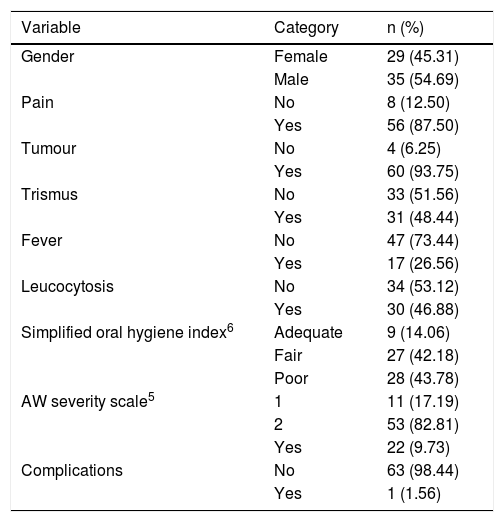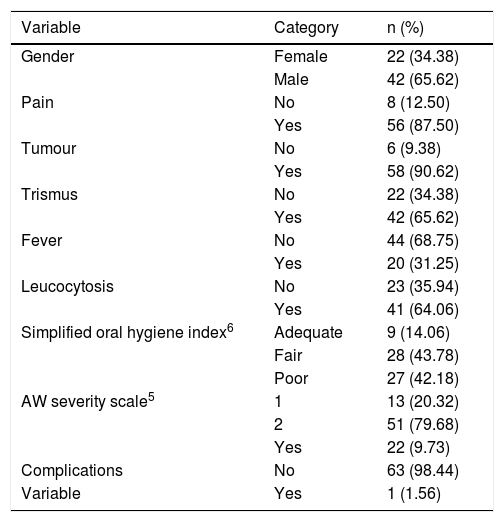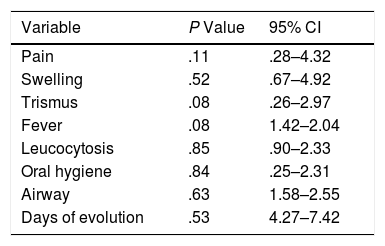The most common cause of deep neck infections is dental infection. They are diagnosed with physical examination, imaging studies, ultrasound, or computed tomography. Surgical drainage of collections should always be performed early in a classical or percutaneous way, depending on the case. The aim of the study was to compare ultrasound-guided percutaneous drainage techniques vs. surgical drainage in deep cervical abscesses of odontogenic origin in a controlled and randomized trial.
MethodsA randomized controlled clinical trial was performed from January 2015 to December 2019. Hospital stay was evaluated as an efficiency variable. Epidemiological and secondary variable data (tumour, trismus, fever, pain), leukocytosis, cosmetic result comparing both techniques were analysed. Statistical analysis was carried out with STATA v 14.0.
Results128 patients were analysed, 51 women and 77 men. Average age 27.3 (SD = 10.13). The percutaneous group had a mean hospital stay of 3.03 (SD = 2.86) days and the surgical group 5.46 (SD = 2.96). The P-value was <.001. Cosmetic results showed differences favouring the percutaneous drainage group. None of the other variables showed statistically significant results.
DiscussionSurgical treatment (cervicotomy and debridement) should be undertaken early with evidence of extensive collection in deep spaces. Minimally invasive image-guided procedures are an alternative. These can be performed in well-located, unilocular collections, without compromising of the patient’s airway. Percutaneous drainage and suction techniques if necessary, serially, or drainage placement may be performed.
ConclusionsUltrasound-guided and serially guided percutaneous drainage is the best therapeutic option in patients with mild and/or moderate dental infections.
La causa más frecuente de infecciones profundas del cuello son las infecciones odontógenas. Son diagnosticadas con examen físico, estudios por imágenes, ecografía o tomografía computarizada. Debe realizarse siempre el drenaje quirúrgico de forma clásica o percutánea según el caso de las colecciones en forma precoz. El objetivo fue comparar las técnicas de drenaje percutáneo guiado por ecografía vs. drenaje quirúrgico en abscesos cervicales profundos de origen odontógeno en forma controlada y aleatorizada.
MétodosSe realizó un ensayo clínico controlado aleatorizado de enero de 2015 a diciembre de 2019. Se evaluó como variable de eficacia los días de ingreso. Se analizaron los datos epidemiológicos y variables secundarias (tumoración, trismus, fiebre, dolor), leucocitosis, resultado cosmético comparando ambas técnicas. El análisis estadístico se llevó a cabo con STATA v 14.0.
ResultadosFueron analizados 128 pacientes, 51 mujeres y 77 hombres. Edad promedio 27,3 (SD = 10,13). El grupo percutáneo presentó una media de 3,03 (SD = 2,86) días de ingreso y el grupo quirúrgico 5,46 (SD = 2,96). El valor de p resultó < 0,001. Los resultados cosméticos mostraron diferencias favor del grupo de drenaje percutáneo. Ninguna de las demás variables mostró resultados estadísticamente significativos.
DiscusiónAnte la evidencia de una colección extensa en espacios profundos la realizacióndel tratamiento quirúrgico (cervicotomía y desbridamiento) debe hacerse en forma precoz. Los procedimientos mínimamente invasivos guiados por imágenes son una alternativa. Estos pueden realizarse en colecciones bien localizadas, uniloculares, y siempre que no exista compromiso de la vía aérea del paciente. Pueden realizarse técnicas de punción y aspiración, y si es necesario en forma seriada, o bien punción con colocación de drenajes.
ConclusionesLas punciones percutáneas ecoguiadas y en forma seriada son la mejor opción terapéutica en pacientes con infecciones leves y/o moderadas.













